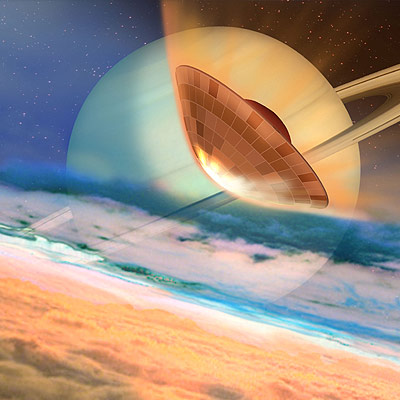

by Michael Hammerschlag
updated Jan '07
JPL's Torrence Johnson on TiTAN landing (realaudio) 4-27-06 Brown U 7:16min on lack of surface liquids, methane-ethane
properties, acetylene icebergs; LAKES FOUND!!!! Jan 2007 Pic at bottom;
HI-RES LANDING MOVIE -spectacular!
HAMMERNEWS.com LANDS SUCCESSFULLY- pics! 7:40am
 Early Friday (Jan 14, 2005) morning (4:50am
EST), the last grand space mission –the 11
year $3 billion Cassini mission to Saturn,
dropped a landing probe into the most earthlike
atmosphere in the Solar System, the heavy
clouds of massive moon Titan. Titan is, with
Ganymede, the largest moon in the solar system*-
at 3200 mi. diameter, bigger than planets
Mercury or Pluto, and possessed with an amazing
primeval blanket of supercooled air- 94+
% nitrogen (Earth is 79%), 2-6% methane,
and the remainder a dirty orange smog of
complex organics. Though having only 1/7th the gravity of Earth, Titan’s atmosphere is 1.5 times Earth’s pressure at the surface (equal to 20ft underwater)
and 4½ times as dense, and extends out 120 miles
(compared to Earth’s 30 miles). But unlike
Earth, the distant frigid world, which gets
only 1% of the sunlight of Earth, is a bone
chilling –178C (-290F, 95K), where the methane and ethane would be liquid, and very close to solid- leading
to speculation of lakes, oceans, and volcanoes of methane or ethane. Radar pics of the surface from the flybys of Cassini didn’t seem to
show any such thing- they’ve only shot a
small portion of the surface, but Huygens
pics seem to show a methane sea, shore, and shoals. The only other solid
body in the solar system with an appreciable
atmosphere, Venus, has sulfuric acid clouds
in CO2 at 100 times Earth's pressure and hellish
700° temperatures.
Early Friday (Jan 14, 2005) morning (4:50am
EST), the last grand space mission –the 11
year $3 billion Cassini mission to Saturn,
dropped a landing probe into the most earthlike
atmosphere in the Solar System, the heavy
clouds of massive moon Titan. Titan is, with
Ganymede, the largest moon in the solar system*-
at 3200 mi. diameter, bigger than planets
Mercury or Pluto, and possessed with an amazing
primeval blanket of supercooled air- 94+
% nitrogen (Earth is 79%), 2-6% methane,
and the remainder a dirty orange smog of
complex organics. Though having only 1/7th the gravity of Earth, Titan’s atmosphere is 1.5 times Earth’s pressure at the surface (equal to 20ft underwater)
and 4½ times as dense, and extends out 120 miles
(compared to Earth’s 30 miles). But unlike
Earth, the distant frigid world, which gets
only 1% of the sunlight of Earth, is a bone
chilling –178C (-290F, 95K), where the methane and ethane would be liquid, and very close to solid- leading
to speculation of lakes, oceans, and volcanoes of methane or ethane. Radar pics of the surface from the flybys of Cassini didn’t seem to
show any such thing- they’ve only shot a
small portion of the surface, but Huygens
pics seem to show a methane sea, shore, and shoals. The only other solid
body in the solar system with an appreciable
atmosphere, Venus, has sulfuric acid clouds
in CO2 at 100 times Earth's pressure and hellish
700° temperatures.
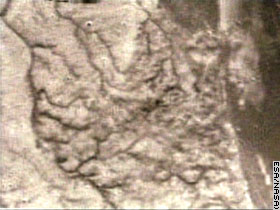
Although the extreme cold would prevent life,
liquid organics react much better than gases
or solids, which are too unconcentrated or
immobile, so Titan is an organic cauldron
with compounds and gases thought to be similar
to the dawn life on Earth- 4 billion years
ago. And it is an ice world: much of the
moon is believed to be composed of a 50/50
(water) ice/rock mixture- the density is
only 1.88 times that of water (Earth is 5.5,
surface rocks about 2.8, and gas giant Saturn
is only .7 and would float in water), so
there may be liquid water at depths to combine
the complex snow of organic compounds into
amino acids and proteins.. the building blocks
of DNA. “Methane is irreversibly destroyed
by solar UV radia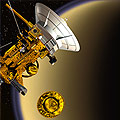 tion at high altitudes in 50 million years,”
says Johns Hopkins Univ. Cassini-Huygens
scientist Darrell Strobel from Darmstadt,
Germany, the European Space Agency’s Operation
Center. (They built the Huygens) “If this
process continued over the age of the solar
system, that’s enough to create 200-300 meters
(layer) of complex hydrocarbons (on the surface).”
Cassini scientists have found diacetylene
and benzene hundreds of miles out in the
atmosphere, amazing for such large molecules,
and can see high white cirrus like clouds.
Titan keeps one side locked to its magnificent
master Saturn and its spectacular rings (which
is now the closest it gets to Earth-visible
all night at opposition) and whips around
it in 16 days at about 3 times the distance
that the Moon is from Earth.
tion at high altitudes in 50 million years,”
says Johns Hopkins Univ. Cassini-Huygens
scientist Darrell Strobel from Darmstadt,
Germany, the European Space Agency’s Operation
Center. (They built the Huygens) “If this
process continued over the age of the solar
system, that’s enough to create 200-300 meters
(layer) of complex hydrocarbons (on the surface).”
Cassini scientists have found diacetylene
and benzene hundreds of miles out in the
atmosphere, amazing for such large molecules,
and can see high white cirrus like clouds.
Titan keeps one side locked to its magnificent
master Saturn and its spectacular rings (which
is now the closest it gets to Earth-visible
all night at opposition) and whips around
it in 16 days at about 3 times the distance
that the Moon is from Earth.

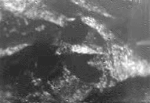
The discus shaped 9 ft. 700lb. shell of the Huygens probe, released Christmas Eve, will slam into the Titanic atmosphere at about 13,500mph (3¾ miles a second) at about 170 miles altitude, heat to 2700 degrees on the shuttle-like ceramic tiles, and violently slow (14G deceleration) to about 900 mph at 90 miles up, where a little 8ft parachute yanks off the top half of the discus and deploys a 27ft parachute. “Titan's atmosphere is much more extended (4 times farther for equivalent pressure) than Earth’s because of the low gravity,” says Strobel. At 65 miles, that parachute is cut away and a smaller 10ft parachute deploys, so that the lithium batteries won’t be used up in the 2 hour 20min drop to the surface. A gas chromatograph, and spectrometer will heat and analyze the atmospheric gases at many altitudes and cameras will madly blast away at the surface. 35 Plutonium pellet heaters keep the craft from freezing blind in the bitter alien skies, and Doppler-shift radio analysis may determine winds [over 310mph measured!] and rocking (inc. of a liquid landing). Radar and acoustic receptors will measure the distance to the surface, the speed of sound, the roughness and constitution of the surface (and depth?). clouds of Titan fm 750 mi Nov '04

Just above the surface brilliant lights are
turned on for the spectrograph and cameras,
as the discus crunches onto the surface at
12 ft/sec (15mph), blasting up data to the
mother ship. The heated gas trap will vaporize
the solid or liquid surface and analyze it
with the spectrometer/chromatograph. The JPL/ESA scientists dream it might land
in a methane and/or ethane lake (it floats),
but admit that would quickly freeze it and
damage components; hopefully many sensors
would first measure the density, temperature,
waves, electrical, optical, acoustic, and
thermal characteristics. Even if it works
perfectly, the surface life is only expected
to be 2¼ hours [lasted longer], when Cassini, about
40,000 miles away, will disappear over the
Titanic horizon; but Cassini will make over
40 more passes by it, as close as 590 miles.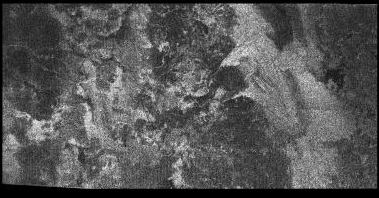
The 6.3 ton (with fuel) Cassini, launched
in 1997, only could reach Saturn by using
convoluted gravity assists- twice from Venus,
once from earth, and once from Jupiter; so
it had to be built to take the furnace heat
inside Venus’s orbit as well as the billion
mile cold of Saturn. At the time, I thought
it was very risky- they shielded it from the sun by hiding
behind the dish antenna (the Galileo main
dish was crippled on its Jupiter mission).
Arriving at Saturn on June 30th, Cassini
had to twice pass through the hazardous bands
of ice and rock in the rings. Everything
has gone tremendously well: on New Years
Day, they flew by the bizarre moon of Iapetus,
one fourth of which looks like it is covered
with shiny asphalt, the rest light. The mission
should function till at least 2008, with
69 fly bys of the moons, and extensive photography
and analysis of Saturn’s moons, clouds, gases,
winds, magnetic fields, and unique rings;
and help to understand the dawn of life. Radar image of Titan surface fm Cassini
Started in 1983- this is the culmination
of a quarter century effort for the cheering
scientists in Darmstadt and Pasadena.
shore of methane
lake with shoals? wider shot below
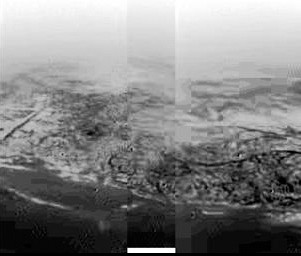 Jan 14 11:30pm The first Huygens picture from 16 km (~10mi)
shows channels that they claim are rivers,
but to me it looks like it could be the tops
of clouds. Incredible, the pic of rocks-
but surprising how much one rockfield looks
like any other (Mars). The 5 mile high shot
shows a jumble with what looks like patches of liquid, and the wide composite
is a lake with whitecaps- the closeup even
shows shoals. They lost one radio channel
from the Huygens, but every bit of data was
recieved from the other- with the 8 time
redundant transmission, into the twin 2.2
gig hard drives on the Cassini- top of the
line in 1996.
Jan 14 11:30pm The first Huygens picture from 16 km (~10mi)
shows channels that they claim are rivers,
but to me it looks like it could be the tops
of clouds. Incredible, the pic of rocks-
but surprising how much one rockfield looks
like any other (Mars). The 5 mile high shot
shows a jumble with what looks like patches of liquid, and the wide composite
is a lake with whitecaps- the closeup even
shows shoals. They lost one radio channel
from the Huygens, but every bit of data was
recieved from the other- with the 8 time
redundant transmission, into the twin 2.2
gig hard drives on the Cassini- top of the
line in 1996.
Jan 21 ESA Bulletin: "These channels merge
into river systems running into lakebeds featuring
offshore 'islands' and 'shoals' remarkably similar to those on Earth...However,
the fluid involved is methane, a simple organic
compound that can exist as a liquid or gas
at Titan's sub-170°C temperatures, rather
than water as on Earth.... Heat generated
by Huygens warmed the soil beneath the probe
and both the GCMS and SSP detected bursts
of methane gas boiled out of surface material,
reinforcing methane's principal  role...Surface images show small rounded
pebbles in a dry riverbed. Spectra measurements
are consistent with a composition of dirty
water ice rather than silicate rocks, rock-like
solid at Titan's temperatures.
role...Surface images show small rounded
pebbles in a dry riverbed. Spectra measurements
are consistent with a composition of dirty
water ice rather than silicate rocks, rock-like
solid at Titan's temperatures.
Titan's soil appears to consist at least
in part of precipitated deposits of the organic
haze that shrouds the planet. This dark material
settles out of the atmosphere. When washed
off high elevations by methane rain, it concentrates
at the bottom of the drainage channels and
riverbeds contributing to the dark areas
seen in DISR images.
New, stunning evidence based on finding atmospheric
argon 40 indicates that Titan has experienced
volcanic activity generating not lava, as
on Earth, but water ice and ammonia.
Instead of liquid water, Titan has liquid
methane. Instead of silicate rocks, Titan
has frozen water ice. Instead of dirt, Titan
has hydrocarbon particles settling out of
the atmosphere, and instead of lava, Titanian
volcanoes spew very cold ice." landing site
composite panorama of surface as landing- methane lake w whitecaps (cu of shore above)

Michael Hammerschlag has written articles about the Voyager missions to the Outer planets, the SETI project, and worked on the Subaru telescope on the summit of Mauna Kea, Hawaii, the biggest astronomical complex on Earth.
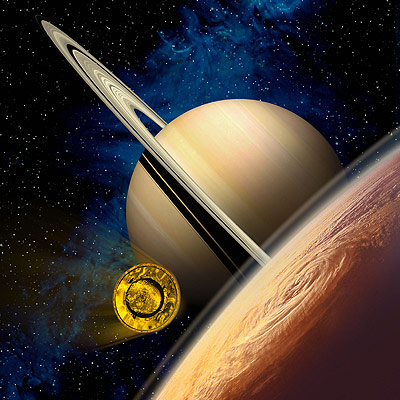
Titan PICS from Cassini: http://saturn.jpl.nasa.gov/news/events/titana/index.cfm
TITAN Facts: http://kvtr.elte.hu/tnp/nineplanets/titan.html
Big JPL Press Release: http://saturn.jpl.nasa.gov/news/press-kits/cassini-arrival.pdf
Huygens Instruments: http://saturn.jpl.nasa.gov/spacecraft/instruments-huygens.cfm
European Space Agency- Huygens: http://www.esa.int/SPECIALS/Cassini-Huygens/index.html
State of Space ’97: http://members.surfbest.net/mikehammer/mhmir2.htm Mir problems, Cassini launch and foretold
Mars missions failures and shuttle disaster
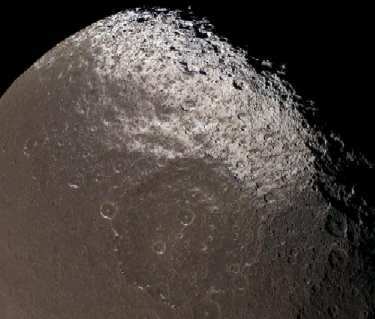
moon Iapetus 888 mi. diameter tar-like color is on top of ice from organic
dust accumulated in orbital passage according
to JPL's Johnson
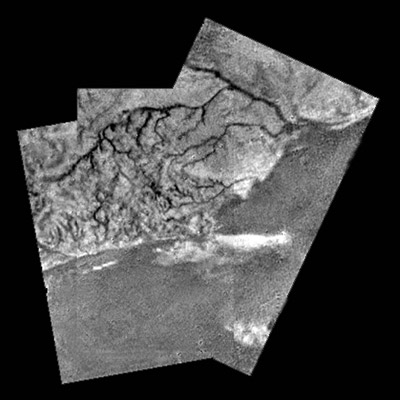
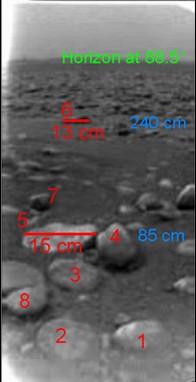 2007 Proven Lakes
2007 Proven Lakes 
River and Delta System
GASES of TITAN ATMOSPHERE
melting point (°C) -182
-183
-188
-210
boiling point (°C) -162
-89 -42 -196
Methane
Ethane
Propane
Nitrogen
formula CH4 C2H6 C3H8 N2
To determine Kelvin temp subtract number
from 273